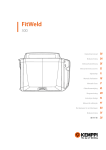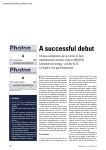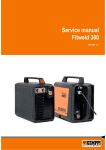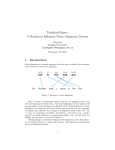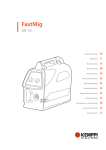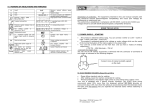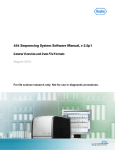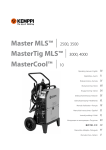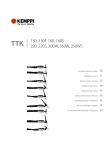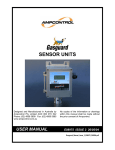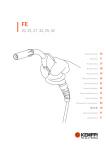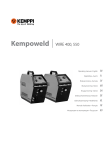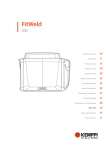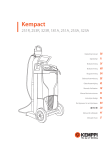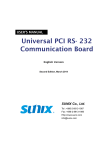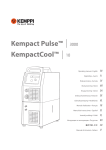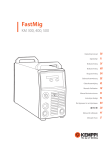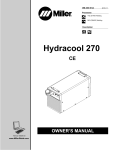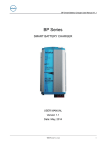Download FitWeld
Transcript
FitWeld Evo 300 Operating manual EN Bruksanvisning DA Gebrauchsanweisung DE Manual de instrucciones ES Käyttöohje FI Manuel d’utilisation Manuale d’uso FR IT Gebruiksaanwijzing NL Brugsanvisning NO Instrukcja obsługi PL Manual de utilização PT Инструкции по эксплуатации RU Bruksanvisning SV 操作手册 ZH Operating manual English Contents 1.Introduction.................................................................................... 3 1.1General. ............................................... . . . . . . . . . . . . . . . . . . . . . . . . . . . . . . . . . . . . . . . . . . . . . . . . . . . . . . . . . . . . . . . . . . . . . . . . . . . . . . . . . . . . . . . . 3 1.2 About welding.................................. . . . . . . . . . . . . . . . . . . . . . . . . . . . . . . . . . . . . . . . . . . . . . . . . . . . . . . . . . . . . . . . . . . . . . . . . . . . . . . . . . . . . . . . . 3 2. Using the machine.. ........................................................................ 4 Before use........................................... . . . . . . . . . . . . . . . . . . . . . . . . . . . . . . . . . . . . . . . . . . . . . . . . . . . . . . . . . . . . . . . . . . . . . . . . . . . . . . . . . . . . . . . . 4 Machine introduction. ................... . . . . . . . . . . . . . . . . . . . . . . . . . . . . . . . . . . . . . . . . . . . . . . . . . . . . . . . . . . . . . . . . . . . . . . . . . . . . . . . . . . . . . . . . 4 Distribution network...................... . . . . . . . . . . . . . . . . . . . . . . . . . . . . . . . . . . . . . . . . . . . . . . . . . . . . . . . . . . . . . . . . . . . . . . . . . . . . . . . . . . . . . . . . 4 Connecting cables. ......................... . . . . . . . . . . . . . . . . . . . . . . . . . . . . . . . . . . . . . . . . . . . . . . . . . . . . . . . . . . . . . . . . . . . . . . . . . . . . . . . . . . . . . . . . 4 2.4.1 Connecting to mains. ............... . . . . . . . . . . . . . . . . . . . . . . . . . . . . . . . . . . . . . . . . . . . . . . . . . . . . . . . . . . . . . . . . . . . . . . . . . . . . . . . . . . . . . . . . 5 2.4.2 Earth return cable. .................... . . . . . . . . . . . . . . . . . . . . . . . . . . . . . . . . . . . . . . . . . . . . . . . . . . . . . . . . . . . . . . . . . . . . . . . . . . . . . . . . . . . . . . . . 5 2.4.3 Shielding gas............................. . . . . . . . . . . . . . . . . . . . . . . . . . . . . . . . . . . . . . . . . . . . . . . . . . . . . . . . . . . . . . . . . . . . . . . . . . . . . . . . . . . . . . . . . 5 2.4.4 Welding gun.............................. . . . . . . . . . . . . . . . . . . . . . . . . . . . . . . . . . . . . . . . . . . . . . . . . . . . . . . . . . . . . . . . . . . . . . . . . . . . . . . . . . . . . . . . . 6 2.5 Installing filler wire.......................... . . . . . . . . . . . . . . . . . . . . . . . . . . . . . . . . . . . . . . . . . . . . . . . . . . . . . . . . . . . . . . . . . . . . . . . . . . . . . . . . . . . . . . . . 6 2.5.1 Mounting the wire spool.......... . . . . . . . . . . . . . . . . . . . . . . . . . . . . . . . . . . . . . . . . . . . . . . . . . . . . . . . . . . . . . . . . . . . . . . . . . . . . . . . . . . . . . . . . 6 2.5.2 Feeding in the welding wire. ... . . . . . . . . . . . . . . . . . . . . . . . . . . . . . . . . . . . . . . . . . . . . . . . . . . . . . . . . . . . . . . . . . . . . . . . . . . . . . . . . . . . . . . . . 7 2.5.3 Setting the pressure of the feed rolls. . . . . . . . . . . . . . . . . . . . . . . . . . . . . . . . . . . . . . . . . . . . . . . . . . . . . . . . . . . . . . . . . . . . . . . . . . . . . . 8 2.5.4 Setting the spool brake force... . . . . . . . . . . . . . . . . . . . . . . . . . . . . . . . . . . . . . . . . . . . . . . . . . . . . . . . . . . . . . . . . . . . . . . . . . . . . . . . . . . . . . . . . 8 2.5.5 Wire guide tubes and wire feed rolls.. . . . . . . . . . . . . . . . . . . . . . . . . . . . . . . . . . . . . . . . . . . . . . . . . . . . . . . . . . . . . . . . . . . . . . . . . . . . . . 9 2.5.6 Changing the feed rolls............ . . . . . . . . . . . . . . . . . . . . . . . . . . . . . . . . . . . . . . . . . . . . . . . . . . . . . . . . . . . . . . . . . . . . . . . . . . . . . . . . . . . . . . 10 2.6 Controlling welding functions. .. . . . . . . . . . . . . . . . . . . . . . . . . . . . . . . . . . . . . . . . . . . . . . . . . . . . . . . . . . . . . . . . . . . . . . . . . . . . . . . . . . . . . . . 11 2.6.1 Control panel functions........... . . . . . . . . . . . . . . . . . . . . . . . . . . . . . . . . . . . . . . . . . . . . . . . . . . . . . . . . . . . . . . . . . . . . . . . . . . . . . . . . . . . . . . 11 2.6.2 Controls inside the machine. ... . . . . . . . . . . . . . . . . . . . . . . . . . . . . . . . . . . . . . . . . . . . . . . . . . . . . . . . . . . . . . . . . . . . . . . . . . . . . . . . . . . . . . . 12 2.6.3 Selecting the gun operating mode. . . . . . . . . . . . . . . . . . . . . . . . . . . . . . . . . . . . . . . . . . . . . . . . . . . . . . . . . . . . . . . . . . . . . . . . . . . . . . . 12 2.6.4 Adjusting the shielding gas flow. . . . . . . . . . . . . . . . . . . . . . . . . . . . . . . . . . . . . . . . . . . . . . . . . . . . . . . . . . . . . . . . . . . . . . . . . . . . . . . . . . . 13 2.6.5 Reversing polarity..................... . . . . . . . . . . . . . . . . . . . . . . . . . . . . . . . . . . . . . . . . . . . . . . . . . . . . . . . . . . . . . . . . . . . . . . . . . . . . . . . . . . . . . . 13 2.7Troubleshooting. ............................. . . . . . . . . . . . . . . . . . . . . . . . . . . . . . . . . . . . . . . . . . . . . . . . . . . . . . . . . . . . . . . . . . . . . . . . . . . . . . . . . . . . . . . 14 2.1 2.2 2.3 2.4 EN 3.Maintenance................................................................................. 15 3.1 Daily maintenance. ......................... . . . . . . . . . . . . . . . . . . . . . . . . . . . . . . . . . . . . . . . . . . . . . . . . . . . . . . . . . . . . . . . . . . . . . . . . . . . . . . . . . . . . . . 15 3.2 Maintenance of the wire feed mechanism. . . . . . . . . . . . . . . . . . . . . . . . . . . . . . . . . . . . . . . . . . . . . . . . . . . . . . . . . . . . . . . . . . 15 3.2.1 Cleaning the gun wire liner . . ... . . . . . . . . . . . . . . . . . . . . . . . . . . . . . . . . . . . . . . . . . . . . . . . . . . . . . . . . . . . . . . . . . . . . . . . . . . . . . . . . . . . . . . 15 3.2.2 Replacing the wire liner........... . . . . . . . . . . . . . . . . . . . . . . . . . . . . . . . . . . . . . . . . . . . . . . . . . . . . . . . . . . . . . . . . . . . . . . . . . . . . . . . . . . . . . . 15 3.3Disposal............................................... . . . . . . . . . . . . . . . . . . . . . . . . . . . . . . . . . . . . . . . . . . . . . . . . . . . . . . . . . . . . . . . . . . . . . . . . . . . . . . . . . . . . . . 15 4. 5. 2 Ordering codes............................................................................. 16 Technical data............................................................................... 17 FitWeld Evo 300 1. Introduction 1.1 General Congratulations on choosing the FitWeld welding machine. Used correctly Kemppi welding machines can increase your productivity and provide years of economical service. This user manual contains important information on the use, maintenance and safety of your Kemppi product. The technical specifications of the device can be found at the end of the manual. Please read the operating manual and the safety instructions booklet carefully before using the equipment for the first time. For your safety and that of your working environment, pay particular attention to the safety instructions in the manual. For more information on Kemppi products, contact Kemppi Oy, consult an authorised Kemppi dealer, or visit the Kemppi Web site at www.kemppi.com. The specifications presented in this manual are subject to change without prior notice. NOTE! Items in the manual that require particular attention in order to minimise damage and personal harm are indicated with this symbol. Read these sections carefully and follow their instructions. Disclaimer While every effort has been made to ensure that the information contained in this guide is accurate and complete, no liability can be accepted for any errors or omissions. Kemppi reserves the right to change the specification of the product described at any time without prior notice. Do not copy, record, reproduce or transmit the contents of this guide without prior permission from Kemppi. EN 1.2 About welding FitWeld Evo 300 is suitable for many MIG/MAG welding applications, but its quick ignition and high efficiency make it especially fast, safe and economic for tack welding of steel materials. It can be used for welding with ferrous, stainless steel and aluminium filler materials. FitWeld Evo 300 is designed for use in demanding environments. It has wire feed cabinet illumination to facilitate wire adjustment in dark conditions, and its case is made of reinforced fibre plastic. Tack welding with the MIG/MAG process Tack welding is used during the fabrication and fitting process, using spot-like welds to establish the joints before primary welding. Using MIG/MAG process for tack welding makes this phase fast and efficient. It is also a safer compared to traditional MMA tack welding. © Kemppi Oy / 1515 3 2. Using the machine 2.1 Before use The product is packed in cartons designed specifically for them. However, always make sure before use that the products have not been damaged during transportation. Check also that you have received the components you ordered and the instruction manuals needed, as described in the Quick start guide. Product packaging material is recyclable. Please also read the Safety Instructions included with the package before use. NOTE! When moving the welding machine, always lift it from the handle, never pull it from the welding gun or other cables. Operating environment This machine is suitable for both indoor and outdoor use. Always make sure that the air flow in the machine is unrestricted. The recommended operating temperature range is -20 ... +40 °C. 2.2 Machine introduction EN 4. 7. 1. 2. 5. 6. 3. 1. 2. 3. 4. 5. 6. 7. ON/OFF Mains supply cable Earth return cable Shielding gas connector EURO gun connector Meter displays Control knobs 2.3 Distribution network All regular electrical devices without special circuits generate harmonic currents into distribution network. High rates of harmonic current may cause losses and disturbance to some equipment. This equipment complies with IEC 61000-3-12 provided that the short-circuit power Ssc is greater than or equal to 1.9 MVA at the interface point between the user’s supply and the public supply network. It is the responsibility of the installer or user of the equipment to ensure, by consultation with the distribution network operator if necessary, that the equipment is connected only to a supply with a short-circuit power Ssc greater than or equal to 1.9 MVA. 2.4 Connecting cables Before you can start welding with FitWeld Evo 300, you must connect the machine to the mains power supply, attach the welding gun and the earth return cable and the shielding gas supply. You must also equip the machine with a filler wire spool suitable for your welding application. 4 FitWeld Evo 300 For quick help about starting with FitWeld, please refer to the Quick Guide delivered with the product information package. 2.4.1 Connecting to mains FitWeld Evo 300 is connected to a 3-phase network using the mains cable supplied with the machine. The cable is not equipped with a wall plug, so you must install a suitable plug before you use the machine for the first time. Check also that the mains cable complies with the local electrical regulations, and replace the cable if necessary. See ’Technical specifications’. NOTE! The mains cable or wall plug may be installed or replaced only by an electrical contractor or installer authorised to perform such operations. 2.4.2 Earth return cable For creating a closed electric circuit needed in welding, you must connect the earth return cable to the connector located on the back of the FitWeld. The other end of this cable will be connected to the workpiece before welding. NOTE! When attaching the earth return clamp to the work piece, remember to clean the work piece surface so as to achieve safe and undisturbed operation. 2.4.3 Shielding gas EN Secure the snap connector of the shielding gas hose to the gas connector on the back of the FitWeld machine. Connect the other end of the gas hose to a gas cylinder’s control valve or to the shielding gas distribution network at your worksite. Make sure that you are using the correct type of shielding gas for the welding application. The shielding gas used for steel wires is carbon dioxide or a mixture of argon and carbon dioxide. The shielding gas used for stainless steel filler wires is a mixture of argon and carbon dioxide (2%). For aluminium filler wires use pure argon shielding gas. The thickness of the parent material, joint type and welding power define the required shielding gas flow rate. To connect the shielding gas hose to a suitable regulator for MIG/MAG welding 1. 2. 3. Connect the shielding gas hose to the gas cylinder’s control valve and tighten the connector (connector is not supplied in the package). Adjust the shielding gas flow rate with the control valve screw. Always close the cylinder valve after use. NOTE! The shielding gas flow rate set from the gas cylinder regulator must exceed the flow rate measured at the welding gun, if GasGuard function is active. If the flow rate and pressure are the same, the gas indicator light will shine on the control panel and welding is prevented. See also instructions and warnings about adjusting the FitWeld's gas flow rate later in this manual. © Kemppi Oy / 1515 5 2.4.4 Welding gun Connect the welding gun cable to the Euro adapter socket located on the front panel and hand tighten only. Do not over tighten the collar. The welding gun leads the filler wire, shielding gas and electric current to the weld piece. When you press the welding gun trigger, shielding gas will flow and filler wire will begin to feed. The arc will ignite when the filler wire touches the weld piece. If no ignition, check that the earth return cable is connected and the clamp has good contact to the work piece. 2.5 Installing filler wire EN With FitWeld Evo 300 you can use up to 200 mm diameter wire spools and the following filler wire types: • solid wires • flux-cored wires • self-shielded flux-cored wires • stainless steel wires • aluminium wires. When choosing the filler wire, remember that the wire must have approximately the same melting point as the base material to be welded. NOTE! When changing the filler wire, always check that the feed rolls, their groove shape and size and the wire liner inside the welding cable are suitable for the wire you are using. Also check that you are using right polarity for the filler wire. 2.5.1 Mounting the wire spool NOTE! The liner and the feed rolls are colour-coded. See that you are using feed rolls that match the colour of the wire liner inside the welding gun cable. See the table of feed rolls and wire liners later in this chapter. With FitWeld Evo 300 you can use wire spools with a diameter of 200 mm maximum. 1. 2. To mount the wire spool: 1. Turn the locking knob of the spool holder so that the locking clips are opened (1). 2. Check the rotating direction of the wire spool and push the spool into its place so that it rotates in the right direction. 3. Turn the locking knob of the spool holder to close the locking clips (2). 6 FitWeld Evo 300 2.5.2 Feeding in the welding wire NOTE! Remember to remove the sharp cut tip of the filler wire before loading the wire to the welding gun, so preventing damage to the liner inside the welding gun cable. This is particularly important for soft filler wires such as aluminium. It will also improve feed quality and increase the service life of your gun liner. For reliable performance only use Kemppi gun liner materials specially developed for use with Kemppi machines. For information on recommended liners and wire feed rolls selection, please see the relevant sections later in this chapter. Be careful not to let the wire unwind from the spool. NOTE! When feeding the welding wire into the gun, be sure that you are not pointing the gun at anyone and that there isn’t anything in front of the gun. EN To feed the wire from the spool to the welding gun: 1. Open the pressure arm of the GT02 mechanism and lift the top roll clear on its pivot. 2. Draw some loose wire from the spool and carefully push it through the bronze wire guide at the back of the mechanism. Push the wire over the feed roll groove and through the front wire guide until it comes out from the Euro connector by about 150mm. 3. Replace the top feed roll over the wire and close the pressure arm. 4. Cut away any deformed wire section and dress the sharp wire tip as described above. 5. Connect the welding gun and tighten the collar. 6. Press the welding gun trigger and allow the filler wire to feed through the gun cable to the contact tip. Check once again that the wire is still properly in the grooves of both feed roll pairs. Now the FitWeld Evo is ready to weld. © Kemppi Oy / 1515 7 2.5.3 Setting the pressure of the feed rolls To make filler wire run smoothly into the wire liner and to the welding gun you can adjust the pressure of the feed rolls of the GT02 WireDrive mechanism. Turn the orange coloured pressure adjustment knob in a clockwise direction to increase the pressure applied to the welding filler wire, and anti-clockwise to decrease it. EN There is a graduation scale marked on the aluminium arm above the orange adjustment knob. The more pressure applied, the greater the number of graduation marks visible. For hard steel and stainless steel filler wires, make sure there is sufficient pressure applied, so avoiding filler wire slippage in the feed rolls. NOTE! Too much pressure may flatten the filler wire, damage its coating, cause friction and excessive wear to drive roll bearings and therefore reduced life. For aluminium filler wires select the correct feed roll type from the chart supplied and adjust for the minimum pressure necessary for reliable filler wire drive. NOTE! Slight slippage is recommended in the case of aluminium filler wires. This ensures that the soft wire is not deformed and flattened and that the feed rolls skid over the soft wire if gets stuck on the gun contact tip. For Aluminium and Stainless Steel filler wires, always use Kemppi DL Chili gun liners. These liners are especially developed by Kemppi and significantly reduce friction loses, so improving welding performance. 2.5.4 Setting the spool brake force To prevent the filler wire from uncoiling on overrun following use at high feed speeds, you can change the brake force of the welding spool. Adjust the spool brake force through the hole in the spool locking mechanism with the Allen key supplied and mounted below the wire drive mechanism. Increase the force by turning the Allen key clockwise and decrease it by turning it anticlockwise. NOTE! Do not over tighten, and reduce the pressure for light filler wire types. 8 FitWeld Evo 300 2.5.5 Wire guide tubes and wire feed rolls Make sure that you select appropriate wire feed rolls/groove type, welding gun contact tip and wire liner for the filler wire used. Kemppi feed rolls and gun liners are colour-coded in order to make identification easy. Wire guide tubes ø mm outlet tube inlet tube W003963 W003962 W003881 W003536 ø mm lower upper 0.8 – 0.9 W001047 W001048 1.0 W000675 W000676 1.2 W000960 W000961 Ss, Al, (Fe, Mc, Fc) plastic Fe, Mc, Fc metal Wire feed rolls, plastic Fe, Ss, (Al, Mc, Fc) V-groove Fc, Mc, (Fe) 1.0 W001057 W001058 V-groove, knurled 1.2 W001059 W001060 Al, (Fc, Mc, Ss, Fe) 1.0 W001068 W001067 1.2 W001070 W001069 ø mm lower upper 0.8 – 0.9 W006074 W006075 1.0 W006076 W006077 1.2 W004754 W004753 U-groove EN Wire feed rolls, metal Fe, Ss, (Al, Mc, Fc) V-groove Fc, Mc, (Fe) 1.0 W006080 W006081 V-groove, knurled 1.2 W006082 W006083 Al, (Fc, Mc, Ss, Fe) 1.0 W006088 W006089 1.2 W006090 W006091 U-groove © Kemppi Oy / 1515 9 2.5.6 Changing the feed rolls To change the feed rolls: 1. Pull and release the pressure tension arm via the aluminium head above the orange plastic adjuster. 2. Lift the upper feed roll on its pivot to the maximum open position. 3. Pull out mounting pin of the upper feed pressure roll and replace the roll with a new one. 4. Open the locking screw of the lower feed roll and replace the roll with a new one. 5. Return the upper pressure feed roll to its down position and replace the locking arm latch. 6. Adjust the pressure tension as instructed in the earlier section. 1. 2. EN 3. 4. 5. When using hard, flux-cored filler wires you should select a knurled feed roll to achieve better grip. 10 FitWeld Evo 300 2.6 Controlling welding functions With FitWeld Evo 300 you can easily control welding parameters, change the welding polarity and gun operating mode. The control panel provides two adjustment knobs. You can set the desired welding voltage and wire feed speed before or during welding, so easily tuning the desired arc performance to the weld. 2.6.1 Control panel functions FitWeld 10 9 8 7 6 5 4 10 9 8 1 2 3 U 7 6 5 4 ON 1 2 3 W003793 With the left-hand control knob, set the value for filler wire feed speed. The maximum value is 18 meters per minute. With the right-hand control knob, set the welding voltage. Adjustment range is from 11V to 32V. The leds on the front panel indicate the following (from top to bottom): • Machine is turned on • Machine is overheated • Error in shielding gas flow I EN A m min U V The leds on the right hand side of the upper meter display indicate the showed variable, either A or m/min. When not welding, the meter displays will show the selected wire feed speed and voltage. When welding, the meter displays will show the actual current and voltage. The parameters can be adjusted during welding and the meter displays will show the new selected value. After welding the meter displays will briefly show an average value of the actual current and voltage. © Kemppi Oy / 1515 11 2.6.2 Controls inside the machine 1. 2. 3. 1. 2. 3. Welding gun operation mode switch. Shielding gas adjustment screw. Cable connections for reversing polarity. 2.6.3 Selecting the gun operating mode EN With the three position switch (1) you can set the MIG welding gun to two-sequence (2T) or four-sequence (4T) mode with GasGuard feature on. If you are using self-shielded flux-cored filler wire (gasless wire), you must select the upmost switch position. This position provides 2T operation with GasGuard feature disabled, allowing welding without shielding gas. To use the welding gun in 2T operating mode: 1. 2. Press the gun trigger down to start welding. Release the gun trigger to stop welding. To use the welding gun in 4T operating mode: 12 1. 2. 3. Press the gun trigger down to start the flow of the shielding gas. Release the trigger to start welding. Press the trigger down again to stop the arc. The shielding gas continues to flow. 4. Release the switch again to stop the flow of the shielding gas. FitWeld Evo 300 2.6.4 Adjusting the shielding gas flow Using a rotameter as shown in the picture, you can adjust the gas flow rate to the gun by turning the shielding gas adjustment regulation valve screw inside the FitWeld Evo 300 wire cabinet. By turning the screw anticlockwise you increase the gas flow to the gun nozzle. Clockwise adjustment will reduce the gas flow rate. 20 15 10 5 M T3 M 2 l/min EN NOTE! The shielding gas flow rate set from the gas cylinder regulator must exceed the flow rate measured at the welding gun. If these rates are the same, the gas indication light will shine on the control panel and welding is prevented. 2.6.5 Reversing polarity Some filler wires are recommended to be welded with the gun in the negative pole, so the polarity should be reversed. Check the recommended polarity from the filler wire package. To reverse polarity: 1. Disconnect the machine from the mains. 2. Pull away the rubber covers to expose the terminal pole connections and allow access to the Allen screws. 3. Using the Allen key attached to the wire cabinet wall, unscrew the pole connection bolts. Note the correct order of washers. 4. Interchange the cables. 5. Install the washers in the correct order and tighten the bolts firmly. 6. Replace the rubber covers correctly. NOTE! The rubber cover must always protect the poles. © Kemppi Oy / 1515 13 2.7 Troubleshooting Problem Cause The machine stops working and the shielding gas indicator is lit. The maximum flow rate at the gas cylinder is set to a lower value than the flow rate you are trying to set with the FitWeld Evo 300 flow adjustment screw. • At the gas cylinder’s flow regulator, set the flow rate much higher than what you are using in welding. The final adjustment of the gas flow rate is accomplished with the adjustment screw located inside the FitWeld’s wire cabin. Poor welding result Several factors affect the welding quality. • Check that the earth return clamp is properly attached, the point of contact is clean and that the cable and its connectors are intact. • Check the voltage and wire speed settings on the control panel are correct for the given wire size and type. • Check that the shielding gas flow rate at the gun nozzle is correct. • Check that the shielding gas is suitable for the filler wire used. • Check that the wire feed is constant, and adjust if necessary. • Check that the mains voltage is not irregular, too low or too high. Overheating indicator lit The device has overheated. • Ensure that cooling air has unrestricted flow. • The machine’s duty cycle has been exceeded. Wait for indicator to turn off. • Too low or high supply voltage. The wire does not move or wire feed entangles Feed rolls, wire liner or contact tips may be defective • Check that feed rolls are not too tight or too loose. • Check that the feed roll groove is not too worn or incorrect size for the filler wire used. • Check that the wire liner is the correct size and is not blocked or worn out. Replace if necessary. • Check that the contact tip is suitable for the wire used and and is not worn out or blocked. EN Main switch indicator does not switch The machine has no mains voltage on • Check the mains fuses • Check the mains cable and the wall plug If the machine’s malfunction can not be corrected with these measures, contact KEMPPI maintenance service. 14 FitWeld Evo 300 3. Maintenance When considering and planning routine maintenance, please consider the frequency of machine use and the working environment. Correct operation of the machine and regular maintenance will help you avoid unnecessary downtime and equipment failure. NOTE! Disconnect the machine from the mains before handling the electrical cables. 3.1 Daily maintenance • Check the overall condition of the welding gun. Remove welding spatter from the contact tip and clean the gas nozzle. Replace worn or damaged parts. Only use original Kemppi spare parts. • Check the condition and connection of the welding circuit components: welding gun, earth return cable and clamp, sockets and connectors. • Check the condition of the feed rolls, needle bearings and shafts. Clean and lubricate bearings and shafts with a small quantity of light machine oil if necessary. Assemble, adjust and test function. 3.2 Maintenance of the wire feed mechanism EN It is recommended to service the wire feed mechanism every time the you change the wire spool. • Check the wear of the feed roll groove and change the feed roll if necessary. • Clean the welding gun wire guide with compressed air if necessary. 3.2.1 Cleaning the gun wire liner Pressure of the feed rolls remove metal dust from the filler wire’s surface which then travels in the wire liner inside the gun cable. If the wire liner is not cleaned, it gradually clogs up, increasing drag, impairing wire feed performance and weld quality. Ultimately this will will causes wire feed malfunctions. To clean the wire liner: 1. Remove the welding gun from the machine. 2. Remove the welding gun’s gas nozzle, contact tip and contact tip adapter. 3. With a pneumatic pistol, blow dry and filtered compressed air through the wire liner. 4. Clean the wire feed mechanism and spool housing with compressed air. 5. Reassemble the welding gun. Firmly tighten the contact tip and contact tip’s adapter. 3.2.2 Replacing the wire liner If the wire liner is too worn or totally clogged, you must replace it according to the instructions in welding gun operating manual. 3.3 Disposal Do not dispose of electrical equipment with normal waste! In observance of European Directive 2002/96/EC on waste electrical and electronic equipment, and its implementation in accordance with national law, electrical equipment that has reached the end of its life must be collected separately and taken to an appropriate environmentally responsible recycling facility. The owner of the equipment is obliged to deliver a decommissioned unit to a regional collection centre, per the instructions of local authorities or a Kemppi representative. By applying this European Directive you will improve the environment and human health. © Kemppi Oy / 1515 15 4. Ordering codes FitWeld Evo 300 FitWeld Evo 300 + FE32 3,5M P2103 FitWeld Evo 300 + FE32 5M P2104 FE32 3,5M 6603203 FE32 5M 6603204 FE35 3,5M 6603503 FE35 5M 6603504 MMT 32, 3 m 6253213MMT MMT 32, 4.5 m 6253214MMT Earth return cable, 35 mm², 5 m 6184311 Shield gas hose, 6 m W000566 EN 16 FitWeld Evo 300 5. Technical data Connection voltage Rated power at max. current Supply current Output 40 °C Connection cable Fuse (delayed) Open circuit voltage Power factor at max. current Efficiency at max. current 3 ~, 50/60 Hz 10.8 kVA 30 % ED I1max 220 – 230 V: 29 A 30 % ED I1max 380 – 440 V: 17 A 30 % ED I1eff 220 – 230 V: 16 A 30 % ED I1eff 380 – 440 V: 9 A 30 % ED 300 A / 29.0 V 40 % ED 250 A / 26.5 V 60 % ED 210 A / 24.5 V 100 % ED 170 A / 22.5 V H07RN-F 4G1.5 (5 m) 220 – 230 V 16 A 380 – 440 V 10 A 220 V AC 42 V DC 440 V AC 86 V DC 220 – 230 V 0.93 380 – 440 V 0.94 220 – 230 V 83 % 380 – 440 V 84 % Welding voltage range Wire spool (max. ø) Wire feed mechanism Wire feed speed Filler wires 220 V -10% ... 440 V +10 % EN 11 – 32 V 200 mm 2-roll feed 0 – 18 m/min Fe solid, Fe cored, 0.8 – 1.2 mm Ss Al LxWxH External dimensions Weight EMC class Minimum short circuit power Ssc of supply network* Degree of protection Operating temperature range Storage temperature range Standards: IEC/EN 60974-1, IEC/EN 60974-5, IEC/EN 60974-10 1.0 – 1.2 mm 457 x 226 x 339 mm 15.4 kg A 1.9 MVA IP23S -20 °C ... +40 °C -40 °C ... +60 °C * See paragraph 2.3. © Kemppi Oy / 1515 17 KEMPPI OY Kempinkatu 1 PL 13 FIN-15801 LAHTI FINLAND Tel +358 3 899 11 Telefax +358 3 899 428 [email protected] www.kemppi.com Kotimaan myynti: Tel +358 3 899 11 Telefax +358 3 734 8398 [email protected] KEMPPI SVERIGE AB Box 717 S-194 27 UPPLANDS VÄSBY SVERIGE Tel +46 8 590 783 00 Telefax +46 8 590 823 94 [email protected] KEMPPI NORGE A/S Postboks 2151, Postterminalen N-3103 TØNSBERG NORGE Tel +47 33 346000 Telefax +47 33 346010 [email protected] KEMPPI DANMARK A/S Literbuen 11 DK-2740 SKOVLUNDE DANMARK Tel +45 4494 1677 Telefax +45 4494 1536 [email protected] KEMPPI BENELUX B.V. NL-4801 EA BREDA NEDERLAND Tel +31 765717750 Telefax +31 765716345 [email protected] www.kemppi.com KEMPPI FRANCE S.A.S. 65 Avenue de la Couronne des Prés 78681 EPONE CEDEX FRANCE Tel +33 1 30 90 04 40 Telefax +33 1 30 90 04 45 [email protected] KEMPPI GMBH Perchstetten 10 D-35428 LANGGÖNS DEUTSCHLAND Tel +49 6 403 7792 0 Telefax +49 6 403 779 79 74 [email protected] KEMPPI SPÓŁKA Z O.O. Ul. Borzymowska 32 03-565 WARSZAWA POLAND Tel +48 22 7816162 Telefax +48 22 7816505 [email protected] KEMPPI AUSTRALIA PTY LTD 13 Cullen Place P.O. Box 5256, Greystanes NSW 2145 SMITHFIELD NSW 2164 AUSTRALIA Tel. +61 2 9605 9500 Telefax +61 2 9605 5999 [email protected] OOO KEMPPI Polkovaya str. 1, Building 6 127018 MOSCOW RUSSIA Tel +7 495 240 84 03 Telefax +7 495 240 84 07 [email protected] ООО КЕМППИ ул. Полковая 1, строение 6 127018 Москва Tel +7 495 240 84 03 Telefax +7 495 240 84 07 [email protected] KEMPPI, TRADING (BEIJING) COMPANY LTD Unit 105, 1/F, Building #1, No. 26 Xihuan South Rd., Beijing Economic-Technological Development Area (BDA), 100176 BEIJING CHINA Tel +86-10-6787 6064 +86-10-6787 1282 Telefax +86-10-6787 5259 [email protected] 肯倍贸易(北京)有限公司 中国北京经济技术开发区 西环南路26号 1号楼1层105室(100176) 电话: +86-10-6787 6064/1282 传真: +86-10-6787 5259 [email protected] KEMPPI INDIA PVT LTD LAKSHMI TOWERS New No. 2/770, First Main Road, Kazura Garden, Neelankarai, CHENNAI - 600 041 TAMIL NADU Tel +91-44-4567 1200 Telefax +91-44-4567 1234 [email protected] KEMPPI WELDING SOLUTIONS SDN BHD No 12A, Jalan TP5A, Taman Perindustrian UEP, 47600 Subang Jaya, SELANGOR, MALAYSIA Tel +60 3 80207035 Telefax +60 3 80207835 [email protected] 1903530 1515 KEMPPI (UK) LTD Martti Kemppi Building Fraser Road Priory Business Park BEDFORD, MK44 3WH UNITED KINGDOM Tel +44 (0)845 6444201 Telefax +44 (0)845 6444202 [email protected]




















